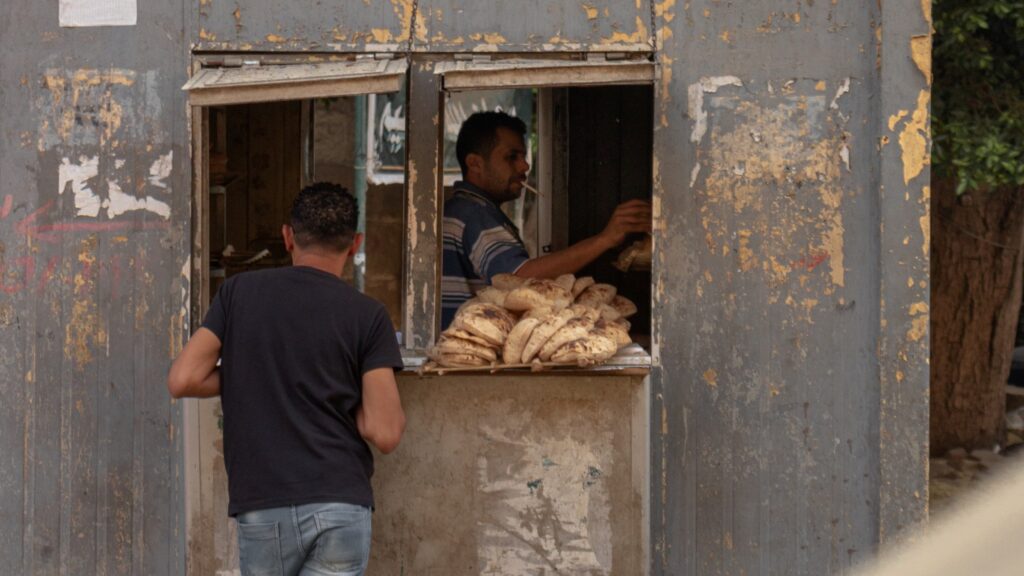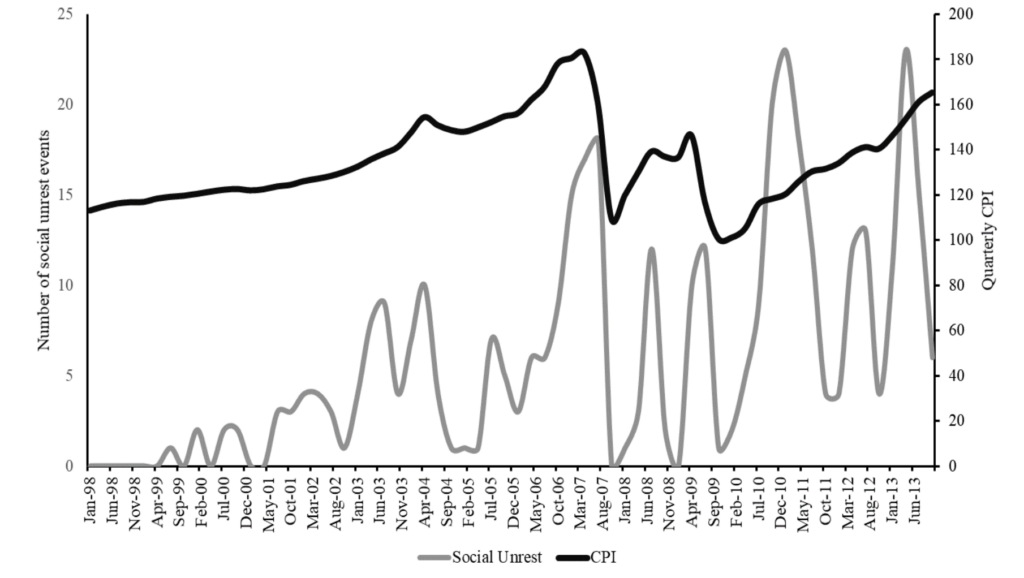Egypt’s food systems and exogenous shocks
Traditionally, Egypt’s food system has been facing longstanding agricultural development challenges and has especially been susceptible to the impact of exogenous shocks, due to a suite of supply- and demand-side drivers, including agronomic, socioeconomic and institutional drivers, which put pressure to eradicate poverty and achieve food security.
On the supply side, burgeoning climatic changes, represented by higher temperatures and direct heat stress, and lower rainfall and increased water needs, bring harsher conditions for food production, particularly in the Nile Delta region where up to 60% of food is produced in Egypt (Badreldin et al, 2019). Recent projections show, for example, by 2050 climate change will significantly reduce crop yields, leading to about 6% decrease in total food production in Egypt, about 15% decrease in wheat production (UNFCC, 2015), 22% decrease in maize production, and around 24% in pulses production (Perez et al., 2021).
Water scarcity is another serious sustainability threat for Egypt’s food production, as the country relies almost entirely on irrigation. Besides climate and environmental changes, water resources in Egypt have been decreasing due to rapid population growth and increasing wealth, which increased demand for food production. With an annual per capita share of renewable water resource ranging between 550 and 560 cubic meters, Egypt has already approached the water poverty threshold and is facing an annual water deficit of about 54 billion cubic meters (FAO, 2016). This constrains the expansion of agricultural area and puts pressure on the capacity of the food system to increase agricultural production and food supply.
On the demand side, Egypt’s population has been growing at 2.1% in recent decades, hitting 100 million inhabitants in 2020, and recording an increase rate of about 14% since the 2006 census (CAPMAS, 2017). In connection with this, rapid and unplanned urban expansion have been associated with massive loss of fertile agricultural land, which is estimated at nearly 30,000 hectares per year (Badreldin et al., 2019). In addition, poverty is widespread in the country. It is estimated that at least 57% of Egypt’s population is either living in poverty or at risk of falling into poverty (World Bank, 2019). Expenditure on food absorbs the greatest portion of Egyptian households’ income (about 45%), which aggravates the consequences of any supply price shocks on household nutrition and food security.
Furthermore, the interplay of these supply- and demand-side drivers of the Egyptian food system has always made the country highly dependent on food imports, reaching 45% of domestic food demand. For example, self-sufficiency ratios for cereals, vegetable oils, oil crops, and sugar crops are particularly low, at 58%, 26%, 35%, and 73%, respectively (Abu Hatab and Hess, 2021). Such over-reliance on global markets for meeting the food needs of Egypt’s growing population leaves Egypt highly exposed to price fluctuations and shocks in international food markets.

A perfect storm’s symptoms and consequences
Since 2020, the combined effects of overlapping global crises posed namely the COVID-19 pandemic and the Russian aggression in Ukraine, which came on top of the above-mentioned challenges and at times of increased financial fragilities — mounting debt, external balance deficits, diminished hard currency reserves, weakened national currencies — which directly threaten food security.
That is, the concurrence of these recent shocks has interplayed and exacerbated the already-existing challenges and added additional pressure on the food system’s capacity to meet the food security needs of the growing population, leading to an unprecedented ‘perfect storm’ that is now striking the country’s food system. Short-run effects are evident by agricultural output contraction, significant shortages in the food supply, disruption in agricultural markets, and sharp increases in domestic food prices, which foreshadow to have damaging effects on food security and to reverse national progress towards ending hunger and eliminating poverty.
There are also obvious signs that this perfect storm may have lasting effects not only on the food system in terms of food supply and food security, but also much wider socioeconomic consequences that could inflame conflict and destabilise the country’s political system. Especially, the large share of food in the consumption basket of Egyptian households (approximately 45%), together with the high dependency of the country on the international markets, imply that rising global food prices and food supply shortages will further stimulate inflation in domestic food prices, and will sharply reduce the purchasing power of poor households.
Since the emergence of the Arab Spring in Egypt in 2011, evidence has accumulated to indicate that disruption to food supply chains and spikes in domestic food prices can trigger food riots and social unrest, by damaging the socioeconomic wellbeing of vulnerable groups of the population and exacerbating the food insecurity and poverty (Abu Hatab and Hess, 2021).

Policy recommendations
The percussions of these recent and ongoing shocks have exposed underlying fragilities in the Egypt’s food system, particularly with the sustainability of local supply chains and access to affordable food among vulnerable populations. Therefore, the efforts of the Egyptian government and its development partners should respond to the consequences of these concurrent crises by deploying short- and long-term responses to boost food security, reduce risks, and strengthen food systems. In the short term, targeted measures should aim at reducing household exposure to high and volatile food prices by scaling up social-protection systems and broadening their coverage and comprehensiveness.
To address immediate needs and lay the foundations for recovery, the government must be at the centre of the response to stabilise access to food by supporting the incomes and purchasing power of those most vulnerable. However, policy actions should also keep a medium- and longer-term outlook towards improving the resilience of food systems to future shocks; systems that are also inclusive and deliver food and guarantee nutrition security. To accomplish this, policies should seek to increase shock-resilience, for example by reducing structural rigidities in production, trade and consumption patterns, and by encouraging sustainable food production to reduce reliance on global grain and food markets. Increased investments in agrifood systems are critical to build the productive capacity of the Egyptian food system and realising the ambitions of the country’s 2030 Agenda.
This requires coordinated actions across a range of policy areas and vast investments, both from public and private financiers to support farmers, processors and other actors who struggle to access the financial resources needed to invest in their agri-food systems. Increasing agricultural output to reduce the reliance on imports also requires smart water management systems, green energy technologies and sustainable intensification of strategic crops through precision agriculture technologies and climate smart agricultural practices.
Integrated agricultural knowledge and innovation systems that deliver advisory support services to producers for sustainable productivity growth and resilience should be developed. In conjunction with these policy actions, demand-side drivers must be addressed and domestic consumption patterns should shift towards healthier and more sustainable diets. Last but not least, promoting regional agri-food value chains and increasing intra-Arab and intra-African trade will also be crucial to forging a shield against external supply challenges and fostering sustainable food supply.
Written by Assem Abu Hatab, Associate Professor at the Department of Economics in the Swedish University of Agricultural Sciences (SLU) and Senior Development Economist at the Nordic Africa Institute.
References:
Badreldin, N., Abu Hatab, A. and Lagerkvist, C.J., 2019. Spatiotemporal dynamics of urbanization and cropland in the Nile Delta of Egypt using machine learning and satellite big data: implications for sustainable development. Environmental monitoring and assessment, 191, pp.1-23.
UNFCC (United Nations Framework Convention on Climate Change). 2015. Nationally determined contribution- Egypt.
Perez, N.D., et al., 2021. Climate-resilience Policies and Investments for Egypt’s Agriculture Sector: Sustaining Productivity and Food Security. International Food Policy Research Institute.
FAO (Food and Agriculture Organisation of the United Nations). 2016. AQUASTAT Country Profile – Egypt. Country Factsheet.
CAPMAS (Central Agency for Public Mobility and Statistics). (2017). Egypt Census 2017. Cairo: CAPMAS.
Abu Hatab, A. and Hess, S. 2021. “Feed the mouth, the eye ashamed”: Have Food Prices Triggered Social Unrest in Egypt? International Association of Agricultural Economists (IAAE) 2021 Conference.
